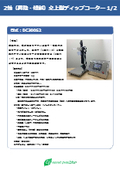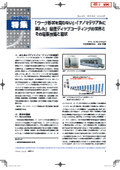Introduction of the anti-reflective coating process using a wet process with superior cost benefits compared to the vacuum dry process: alternating layer method and equipment.
Please consider the anti-reflective film formation using the "alternate layering method," a wet process that can be coated at room temperature and atmospheric pressure. The mainstream dry processes for anti-reflective film formation, such as vacuum deposition, require vacuum conditions, making them costly. On the other hand, the "alternate layering method" in the wet process involves immersing a substrate alternately in two types of solutions (cationic and anionic) at room temperature and atmospheric pressure, eliminating the need for vacuum conditions. The cost advantages are expected to show a significant difference not only during the testing and verification phase but also in the mass production equipment stage.
Inquire About This Product
basic information
● What is the Layer-by-Layer (LbL) Assembly Method: - Positively charged polymer solution: Cationic solution - Negatively charged silica nanoparticle solution: Anionic solution - This method involves alternately immersing a substrate in these solutions to build up thin films. - After each immersion and layering treatment, a rinsing process is performed. - Cation ➡ Rinse ➡ Anion ➡ Rinse: This sequence is repeated. * Cation and anion are layered with a thickness on the nano scale, ultimately achieving the desired film thickness (for example, 100 nanometers). ● Experimental Equipment Configuration (Simplified Specifications): - Small dip coater - A turntable mounted on the base of the same device - At least four beakers or similar liquid tanks installed within the turntable - Processing speed: 0.1 mm/s to 30 mm/s - Repeated lifting and lowering operation is necessary: To demonstrate the shaking action during the rinsing process - Turntable rotation operation - Specification of the number of process repetitions * Optionally, a quartz crystal oscillator for film thickness measurement ● Production Equipment: - Specifications will be finalized based on data obtained from experiments Managing the materials of each solution and the rinsing liquid is a very important factor.
Price information
- For experimental equipment, the cost is approximately 2 to 3 million yen for a tabletop size. - The cost of mass production equipment varies depending on the specifications, so consultation is required.
Delivery Time
Applications/Examples of results
Anti-reflective film
catalog(17)
Download All Catalogs


Company information
We are a specialized manufacturer of dip coating and cleaning and drying equipment for the preceding and following processes. Our company is a "team of professionals" that has been active in the industry for many years. We manufacture experimental and prototype machines based on our extensive experience and achievements (handling various substrates, shapes, and coating agents) and utilize valuable know-how gained from test coatings (liquid management, air conditioning management, etc.) to produce and sell experimental and production equipment. Aiming to propose the optimal coating system for our customers, we provide a one-stop solution for "experimental machines, test coatings, prototype machines, and production (mass production) equipment" covering the "cleaning, dip coating, and drying" processes. We also offer simple free tests, so if you are considering coating, currently facing difficulties, or wondering if a certain coating can be done, why not try applying it? Please feel free to contact us.





















